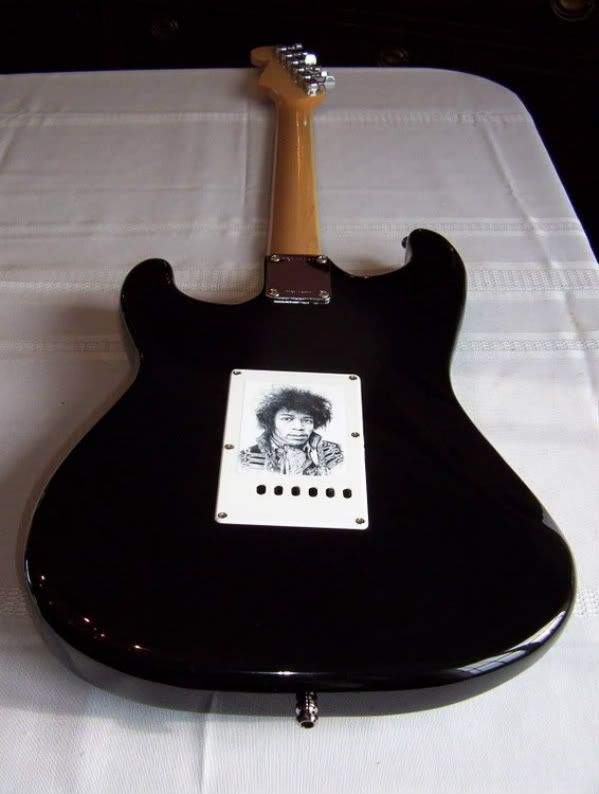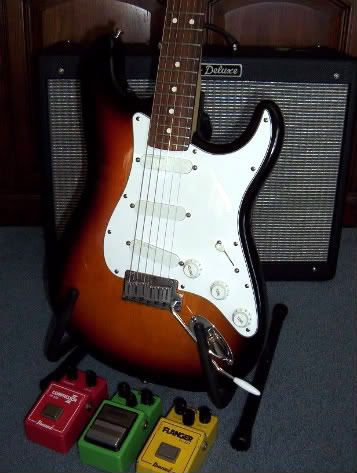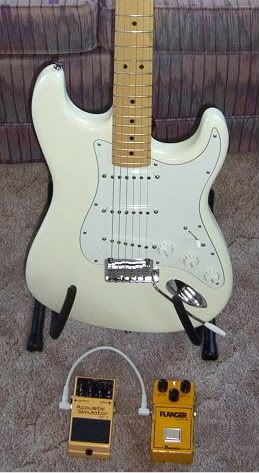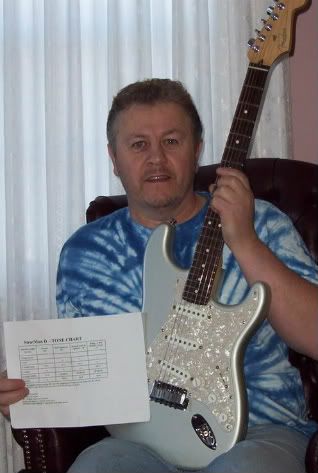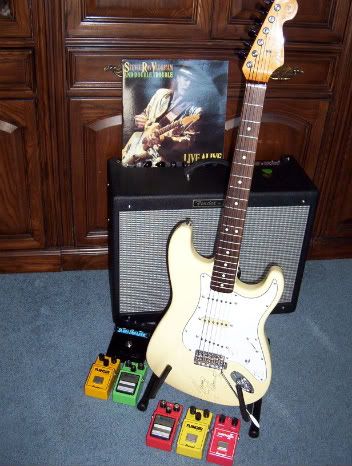Hey everyone, I'm new to this forum and so far it has been a ton of help. I'm trying to fix my loose jack problem currently on my acoustic electric. I can honestly say I'm not one to mess with stuff on my guitars until I actually know what I'm doing because I'm destined to mess something up.
That being said, can someone give me some advice regarding lowering the action on my acoustic electric. Beyond the 5th fret I feel like I'm pressing down forever to hit the board. I know I need to "sand down" the saddle, but don't know how much or how to even begin to get it out. I had a custom bridge made of bone put on and it helped improve tone. Has anyone ever done this with the saddle as well?
Thanks!
Blakley Leonard
Music here: http://www.facebook.com/blakleyleonardmusic
http://www.youtube.com/blakleyleonardmusic
What make/model is your guitar?
Do you have a picture of the bridge area that you can show us?
the "how to" depends on what you have to work with.
Also, just a clarification on terminology.
The bone part is the saddle, the wooden part under it is the bridge.
Getting the terminology right will make it easier for someone to explain what needs to be done.
I wrapped a newspaper ’round my head
So I looked like I was deep
Hey Blakley, I listened to your music when you joined the forum and got a feel for how the acoustic was playing, yours or someone else's? Welcome - I'll comment when I have time, but might have put a "like this" on your Facebook. The guitar had the dynamics of most Gibsons and some Taylors, but then I wouldn't think you would have needed to upgrade the saddle, or be having action problems. Whatever you did, you made it sound good with your modifications, and the woody timbre was there with good mids and trebles (for a pure acoustic!) and sounded like bright, clean new strings as well. 8)
Maybe you need to sight down the neck and observe the dip or the bow in about the middle - if it dips down and leaves the strings running high up off the board, you have high tension either in the strings themselves, or in the gauge, and might need a truss rod tightening, when the strings are slacked off and not under tension. If your climate or guitar's room has been dry, this can happen, but when your weather is either hot or humid, the neck can go the opposite way by itself, and have a negative bow, which is either a straight neck or a hump. You might have excessive positive bow, or the dip in the middle? Just a thought - you look at that first because it precedes or eliminates the need for saddle filing. But the mere fact that you had your saddle made, is curious and creates suspicion in that area. Even more so, if there is the added height of an under-saddle transducer.
Yes, I have made several saddles out of bone blanks for DIFFERENT BRANDS of acoustic guitar, and have also filed and fitted the more convenient, compensated micarta, oversize saddles. I also made a saddle of metal once, filed grooves in it for the strings, and painted it white. I have fixed split bridges with super glue or epoxy, filled in cracks, sanded them down, and sometimes spray painted the rosewood black, if it was damaged by tension or dryness, and of course masked off the rest of the guitars, with good results.
If you determine that your neck has the right attitude :shock: and you have to remove your saddle, loosen the strings, a whole lot, take the load off big time, they got to be really slack, so that you grab the saddle (which I do carefully with side cutters/string clippers) and pull it up and out. Check and see that it's groove has not been shimmed, or that there is nothing in the way. If there is a shim, or foreign object, remove that, and put things back together. If you have to file the bottom of the saddle, draw a line on the bottom, or blacken it evenly with a permanent marker, no more than 1 mm. to 1.25 mm. thick. Normally you can just draw that on by following the bottom of the saddle as an edge. In extreme cases where you need to file down more, use a thin Sharpie and a ruler, and draw the line wherever it needs to be. Now grasp the saddle fimly, hold it upright, and run the bottom over a piece of sandpaper which you hold or anchor down, or best - over a cutting file.
File back and forth, and try to keep the bottom of the saddle flat. If you wanted to progress into more detail, and into the workings of a guitar tech, you realize that the saddle is going to get pulled forward, and 'lean' like the tower of Pisa :lol: when the strings are tightened, and you can give the bottom that bit of angle in advance, so that it will contact the bottom of the bridge's saddle groove all-flat, when under tension. Be careful, bone nuts are brittle and they can snap easily. Always keep a firm grip on it, don't make any sudden moves, or go over the edge of any file. Sand or file it down until you are at your marker line, or until the marker line has disappeared, leaving only freshly filed and FLAT saddle. Voila, and good luck!
See some bow in necks, fairly straight or horizontal compensated saddles, though I sometimes go lower on the treble side: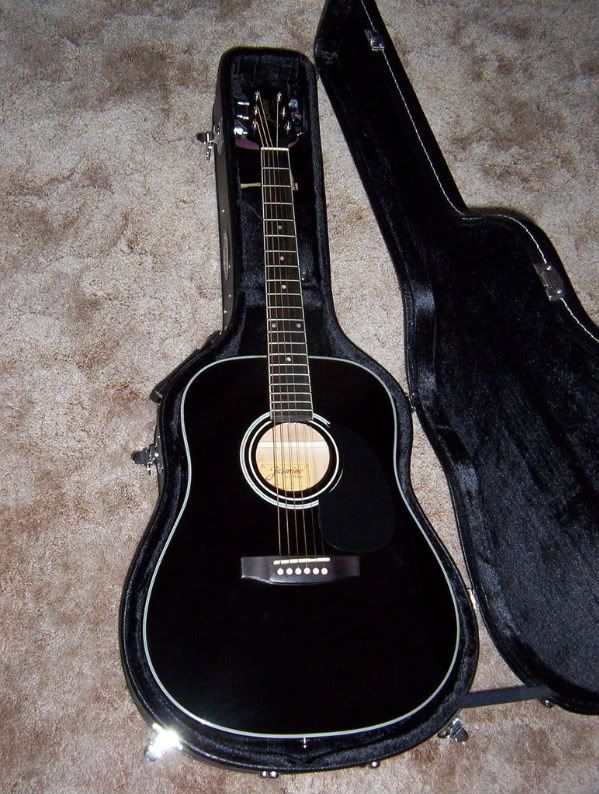
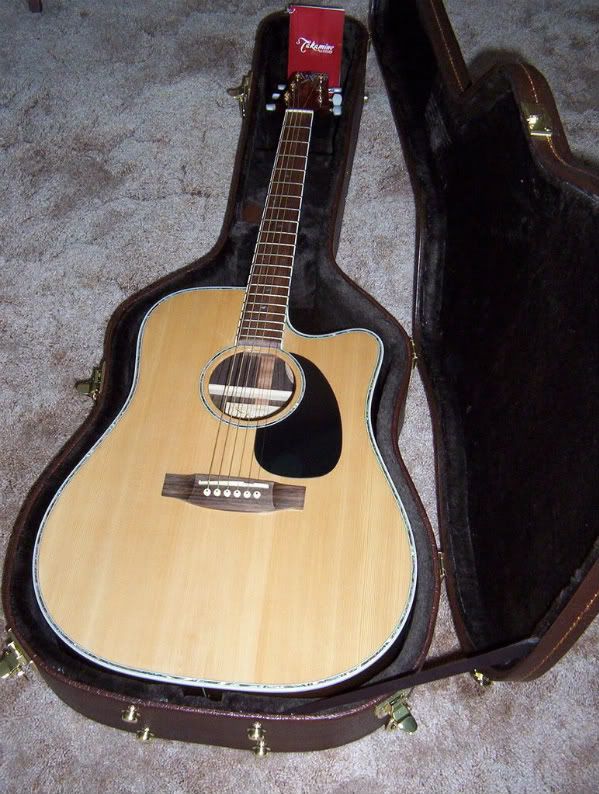
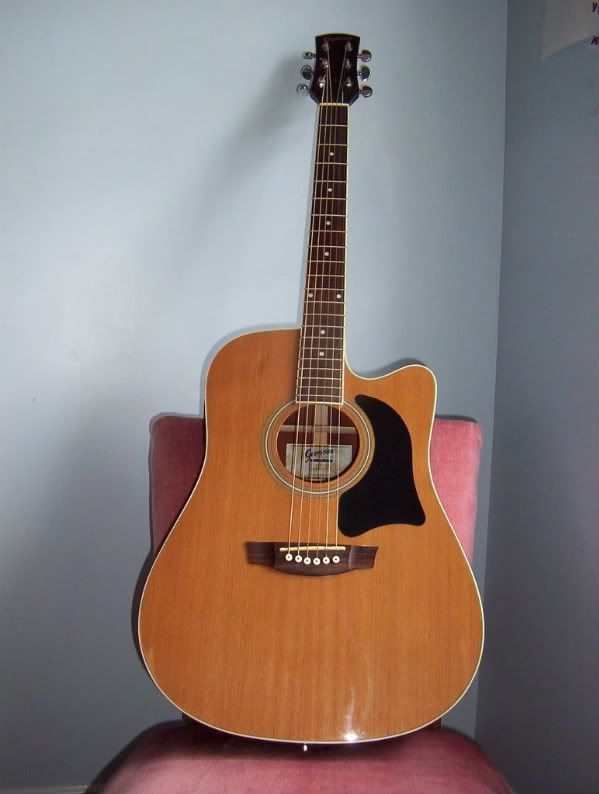
Like a bird on the wire,
like a drunk in a midnight choir
I have tried in my way to be free.
Sorry about the calling the part I was originally talking about (having made out of bone) the bridge, I meant the nut haha. Anyways, the saddle on my guitar is stock as of right now. My guitar that I use mainly is a Spencer SO-SG560E and is also the one I made my recordings with. I used three mics when recording the tracks: one at the board, one at the sound hole, and one on the wood of the body to get a good mix of natural tones and then put some good eq. Oddly enough, the Spencer is a thin body too. I also have a Martin 1833 Dreadnought Rh-1 N but haven't used it because it has bad strings that I never change because it's not electric so I can't use it for shows.
Thanks for listening to some of my music. I really appreciate the kind words and hope you do like it.
I can see that my neck isn't flush with the body and tends to curve very slightly inward with the tension of the strings. Is that possibly the problem? Regardless, I have always been told by other players that my action is extremely high. Up until recently I just dealt with it but it would be much easier to do certain things on if it were lower.
I'm not sure if this is any relation to this, but when I hit certain notes, a buzz will come from the pins/bridge of my guitar. This has me clueless as well. Thanks for all the help! I will upload a picture if I can, I'll have to borrow a friends camera.
Blakley Leonard
Music here: http://www.facebook.com/blakleyleonardmusic
http://www.youtube.com/blakleyleonardmusic
Kent was on to something when he asked for a clarification of terminology. 8) :
So, you had a nut made, but I'm not thinking that it is a height problem there, or you would feel excessive clearance of the strings or high action with difficulty pushing down or fretting, early on the board, in the open chords.
If you feel you are having to apply too much pressure, you and your advisers are right about having high action; we just have to determine whether it is due to the straight & steady rise of the strings toward a high nut or take-off point, or if it is really due to excessive bow in the neck itself. Your bow doesn't sound too bad, if it is just a light dip or curve. I have no specs on that, I eyeball them, and go by the touch; presence or absence of fret buzz above the 12th, especially around the 14th fret etc. In actual fact, I made a toothpick as a dipstick, drew a red line on it like a thermometer, colored in the bottom, and I also made the same thing with a plain straight black line, and I "dip it" to check for string height at the first and 12th frets. It's an arbitrary thing or measurement that I am comfortable with, and whatever my guitars will take, trying to be on the low side, without buzzing. If action is high, I observe "how high is too high" over my mark (at the 12th), and that's how much I want to remove from (or lower) the saddle, all other things being okay.
I got separated from my toothpicks awhile ago :shock: and it seems I am not around any rulers that have meaningful markings on them. I have one here that is metric but also weird, and I would like about 3 mm. of string clearance, including the string if it's an (.042) on an electric; that 3 mm. may be 3/20 of an inch - this ruler is very strange! Okay - I fixed it:
I started again, got a brand new tooth pick and measured the distance of the string from the board at the 12th fret, on my favorite Tele, which is the most recent - I built it about 3 months ago with a set of .009 - .042's on it, given to me by the Fender dealer (or else I buy 10 - 46's)... the clearance including the string is exactly 3 mm; I had set it up by feel, and had a bugger of a time with it, with both a new bridge and a new out-of-adjustment neck, and first time marriage of the neck and body. So, again, what I did was to place a toothpick standing up in the 12th fret space, and draw and fine line where the top of the string crosses the toothpick - like a dipstick, yes. Then I moved the toothpick over to my favourite and best-behaved acoustic/electric, the Tacoma with a .054 E string, and marked the line, and it's 5 mm. where the fat string crosses the stick. Those are my benchmarks, even though I don't have a bench, just a room at the moment, for 2 weeks.
If you're confused, BTW, there are two points of relevance to this toothpick/dipstick business. People used to bring their guitars to my house with their problems, and I used my toothpick there as a way of measuring relief, or height of their action; and if it is too high - make a new mark in super sharp pencil, and that tells you how much you want to lower the action, drop the saddles, or file an acoustic saddle (or remove shim) to mimic my setup, assuming that my set up was okay with others. Most liked them - not trying to be a snob, but people just checked my guitars at a coffee house or something, effects chains too, the whole deal, and often wanted either the guitar itself, or the set up? :shock: I let them it have it, where practical, ha ha, the guitar or the set up secrets. They had to go buy their own pedals, mine weren't up for grabs - BOSS AC2 with a Strat instead of an acoustic, chorus and flanger - when I just wouldn't use an acoustic or the soundman wouldn't put the guitar loud enough, I used the volume knob myself. You get what you want and no feedback if the tech people don't?
Finally, I hope that your buzz or vibration near the bridge, is not a loose brace, which is what I usually find, if there's "distortion" inside an acoustic. You may be lucky and just have a wire from undersaddle pickup, if it's there, touching something, or loose pins - I kept some guitars long enough or bought old ones with worn and oversized holes in the bridge.
More likely, change your strings before you do any of these adjustments. Used strings don't apply the tension evenly, and tend to stretch, and then you have a different scenario when you put new ones on... and get bewildered all over again? :lol:
Like a bird on the wire,
like a drunk in a midnight choir
I have tried in my way to be free.
wow.
So I know it's not the nut. I'm almost positive it's the saddle that needs to be lowered. And my neck seems to be straight enough. It only gets difficult to press down strings up towards the 9th fret and so on. I'll have to see what I can do about that toothpick tool. It sounds very useful and if it works, why not?
I'm hoping you were saying that you sold your guitars where practical (not just let them have it) to people interested in your set up. Speaking of which, what set up secrets do you have? My pedal set up in order from left to right is: Boss RC-20XL loop station, Ibanez ts-808, Boss mt-2 (don't like it), Boss CE-5 Chorus, and a Boss TU-3 tuner. All of this powered and rigged on a Behringer pb600 with daisy chain and power supply.
I don't think the vibration is a loose string or something like that. I'm afraid it is a loose brace. What does that even mean? This is just based on the sound of the vibration. It doesn't do it if I press firmly on the bridge. And again, it's only certain frequencies. BTW the strings are 2 weeks old so I don't think it has to do with that either. I know the pins don't always cooperate when I put new strings on and some tend to protrude more than they should.
Thanks!
Blakley Leonard
Music here: http://www.facebook.com/blakleyleonardmusic
http://www.youtube.com/blakleyleonardmusic
So I know it's not the nut. I'm almost positive it's the saddle that needs to be lowered. And my neck seems to be straight enough. It only gets difficult to press down strings up towards the 9th fret and so on. I'll have to see what I can do about that toothpick tool. It sounds very useful and if it works, why not?
I'm hoping you were saying that you sold your guitars where practical (not just let them have it) to people interested in your set up. Speaking of which, what set up secrets do you have? My pedal set up in order from left to right is: Boss RC-20XL loop station, Ibanez ts-808, Boss mt-2 (don't like it), Boss CE-5 Chorus, and a Boss TU-3 tuner. All of this powered and rigged on a Behringer pb600 with daisy chain and power supply.
I don't think the vibration is a loose string or something like that. I'm afraid it is a loose brace. What does that even mean? This is just based on the sound of the vibration. It doesn't do it if I press firmly on the bridge. And again, it's only certain frequencies. BTW the strings are 2 weeks old so I don't think it has to do with that either. I know the pins don't always cooperate when I put new strings on and some tend to protrude more than they should.
Thanks!
You're welcome, I'll try to be brief this time, though I might have 40 years of stories, most of my adventures in electronics happened in the last in the last 17 - 20 years, with the exception of one notable when I brought my first electric guitar to a Coffee House when I was just 17, you know what I mean; my first Telecaster, the people thought it was strange, and way too loud, they complained, but they had to listen, I was the only performer and it was entirely my carload of gear, including the whole P.A. That really curbed my enthusiasm to "go electric" - what the heck, Dylan had done it and lost some fans, but I stayed in the acoustic genre for a few more years then looked for other ways to cheat and add sounds. And I don't consider myself a performer, I just perform anyway, or regardless and do it for charitable causes. It didn't matter, there were bigger and better Coffee Houses to follow at University, already did them when I was 'little' and they didn't appreciate it then, and I also played with many bands in bars when I was just a patron, but we talked, I wanted to learn, not be put on the spot. :shock:
So what started this going off-topic, sorry, was when I just carried in both my hands, a recent Strat and the Acoustic Simulator plugged into the old Flanger, and proceeded to set myself up simply at a bigger, more adult and significant Coffee House in modern times, I grabbed the cord to the board, like I was supposed to, plugged in the two yellow boxes, and brought my own guitar cord, probably in my pocket, and proceeded to play and delivered sound nobody had ever heard. That was when a number of people approached me afterwards to see how I got the acoustic sounds, with more volume and as they questioned "spacey sounds and jets flying in the background"? (I was doing it all around my theme song, "Angel" by Hendrix) A few performers said they'd try it, might get a Strat and best of all the organizer hugged me, but I think that the sound man who devoted so much his time as a volunter too and owned the equipment overruled her, so I didn't get recalled.
Okay, yes I gave my guitars away to people who wanted them badly or needed them, but I sold 2 out of every 3, and often for prices from $50 to $150. Sometimes, for a lot more, waaaaay more, but it depended on who the person was, of course.
You have a nice pedal set up for sure, but I'm not in a position to be an expert on that, though I've seen a lot and your set up would be excellent. I have more too, but like to be simple, and never get paid for being big or bombastic? I also use a Fuzz Face and original Cry Baby, and other things at random, but usually for some reason. I just bought a Landmine Chorus because I got separated from much of my gear, initially all of it, but we're getting some back, over time. A family matter. My daughters gave me their Teles and their acoustics when I left, and whenever I go 600 miles back home, I get more of it.
About my "secrets", well I was sort of referring to that stunt with the Strat and playing Hendrix at a Coffee House. But many episodes have occurred, I can't tell them all - basically it's about making making a lot of noise, or different sounds with a Strat, and some folks, mostly players themselves, come to see wassup? It's weird and wonderful stuff, like having a humbucker, side by side or stealthily stacked in a Strat, where guys expect single coils, and 1 meg ohm pots and special capacitors, blenders, TBX, delta tone and toggles, 10 tones or 11 with my own wiring, or using Deaf Eddies Fat-O-Casters of all kinds, for more powerful sounds and fullness, in series, or parallel or combinations thereof, and maybe sounding like a Les Paul or a Superstrat - if I could play half decent! :lol: One thing that drives guys nuts is how these things can drive tube amps into a frenzy, and overdrive them, where the amp belongs to somebody else, and I fill in or guest, or jam, and drive their amps where their guitars wouldn't do it, or when I play without effects, only using a dirty channel. I'm not good at all, but have been asked if I was Eric Clapton because some poor people in small towns where I play (and bless their hearts)... they all came out; they recognized the look of Clapton's gear, and one group thought that I was Edge from U2, that was odd. I like to pay tribute to my mentors, and to respect SRV and Jimi. Audiences know that they're gone, but some can recall the appearance of their guitars and stuff? Little kids always thought I was Elvis when I had sideburns. Give THEM the credit! 8)
Darn, too many long stories like that. Anyway, a brace in your guitar would be a wooden cross member supporting the top. I have repaired them with wood glue when they come loose - just a little glue, or it can dampen the tone, if it's fixable, and they usually are. However, you could also try a new set of pins that fit tighter, just so slightly. See a guitar tech for those.
Like a bird on the wire,
like a drunk in a midnight choir
I have tried in my way to be free.
Sounds like some pretty good stuff. I like Jimi's lefty strung upside down. All the guitars look great though. I'd like to get a Cry Baby eventually and definitely could use a flanger (I'll add them to my list haha). Giving away your guitars... you're a better man than I. But props none the less.
Hopefully I can get my guitar checked out soon. I can only hope it's not a brace, sounds more expensive to fix. I'll let you know how that goes.
Blakley Leonard
Music here: http://www.facebook.com/blakleyleonardmusic
http://www.youtube.com/blakleyleonardmusic
Take a look at this, and see if it makes sense to you.
And if it's within your comfort level to do something like that.
I wrapped a newspaper ’round my head
So I looked like I was deep
It definitely makes sense. I understand what I need to do, it's just a matter of doing it now. I've never really done anything besides restringing my guitars so this should be interesting. Hopefully it will work out. Is it true that it's bad for the guitar to be left without the strings on for long due to the lack of tension? I guess it could cause the neck to warp?
Blakley Leonard
Music here: http://www.facebook.com/blakleyleonardmusic
http://www.youtube.com/blakleyleonardmusic
You asked: "Is it true that it's bad for the guitar to be left without the strings on for long due to the lack of tension? I guess it could cause the neck to warp?"
Yes, I would say so, though it is sometimes a 'politically sensitive' argument where one person says this and another says that. I do what's right for me, and recommend what I sincerely think is best for others, not intending to cause harm. I don't leave a guitar unstrung for a long time, but have necks lying around for years, same thing, or condition. I like to loosen the truss rod slightly or just have it barely snug, so that the neck won't go into such a back bow condition that I can't get string tension to produce positive bow. Or you never know, the neck could shrivel up and go the other way - what if you got too much bow? Then, presumably, tightening ANY truss rod would take that out, but why make it hard, especially with string tension, up to 200 pounds of pull per string acting to bow it? I store necks and even strung guitars with slackened tension, differs per string, though I have no way of measuring it except by feel when I pull them, in a way that offers homeostasis. "Homeostasis is the process of maintaining a constant internal environment despite changing external conditions."
There are basically two types of rods, single action only acts against string tension and forces the neck straight or into negative bow (a hump), and dual action, which can immediately pull the neck into a bow, and doesn't wait for gradual string tension. I really pay attention to this stuff, especially with my 12 string, to keep it ready and playable at all times. If I take it to a jam session, or a Coffee House where all people play simultaneously and accompany one another, there can be as much as 3 hours straight playing, and it's hard to do with a 12. Actually, I haven't done that yet, I would take a half time break and switch guitars.
Like a bird on the wire,
like a drunk in a midnight choir
I have tried in my way to be free.

